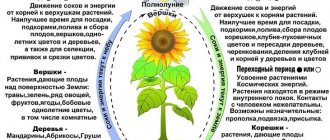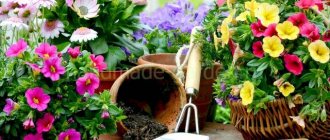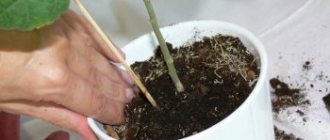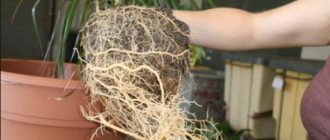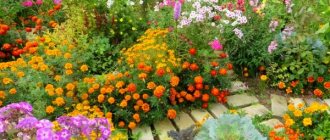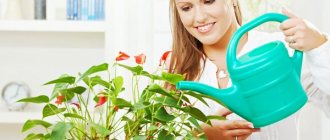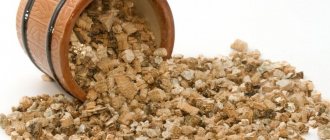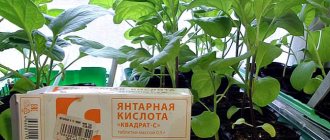Solitaire composition
A tapeworm is a garden decoration using a separately growing tree, bush or grass with a tall stem. Therefore, a home solitaire composition consists of several large and compatible plants that have an unusual shape, color of leaves or flowers.
The best species for this are palms, monsteras, ficuses and codiaums. Tall flowers should be planted in bright, non-standard shaped pots with an unusual texture or pattern. By the way, tapeworms are suitable not only for decoration, but also for zoning rooms. Tall colors make it easy to separate areas of the room that have different purposes. Solitaires can also fill an empty niche or corner.
What flowers should not be planted in one pot?
In this regard, one should not compare light-loving papyrus, yucca, and Kalanchoe
or
colored varieties
of indoor flowers (for example, codiaeum variegated is called croton) with partial shade-preferring
ferns, ivies, spathiphyllums or begonias
.
Flowers that have different indoor humidity requirements should not be combined in one composition. Species that prefer constantly moist soil (for example, spathiphyllum, fern, dwarf ficus, fittonia
), you cannot plant in the same pot with plants that are sensitive to excess water in the soil (for example,
succulents, dracaena, hoya, Saintpaulia violet, sansevieria
), they will quickly lose their decorative appearance and begin to get sick. Some will suffer from drought (the leaves will dry out and the flowers will become susceptible to attack by pests, such as spider mites), others will wither due to overwatering (root rotting, death of plant parts, fungal diseases).
In the photo: caladium 'Aaron', cirtomium crescent, heuchera 'Key Lime Pie', spotted lilyweed 'White Nancy', ivy and pink catharanthus.
Compositions from potted plants
In order to create such a composition, select several types of plants that are united by a common color or leaf shape, as well as similar shades of flowers. Don’t forget to choose several beautifully flowering or decorative foliage species, as they will become the main accent of the composition.
To make your creation look even more harmonious, plant all the flowers in the same or similar pots in concept. You can decorate a window sill, shelves or a small area on the floor with a potted arrangement.
Decorative planting schemes for container gardens
Placing flower arrangements in garden containers and pots is the best solution not only for small areas, but also for those where there is enough space for a full-fledged flower bed. After all, for example, from potted containers you can organize an elegant summer composition in the form of a flower bed.
Flower garden diagram
In addition, container gardens do not have problems with wintering; they can simply be brought into the house, winter greenhouse or winter garden for a cold period of time.
First, let's look at the diagram at the very top of the article; it is perfect for a small flower garden or flower bed in a small compact area.
So, in this floral arrangement scheme, unpretentious and familiar garden flowers are used:
- A – Rose of Sharon or Hibiscus,
- B – Cuphea llavea (Cuphea lavia),
- C – Penstemon,
- D – Asclepias tuberosa,
- E – Petuniia (blue variety of Petunia)
This compact flowerbed will look perfect with homemade stones for the garden path; in addition, some plants can be planted directly into a pot (kufeya), and some, if handled correctly, can be transplanted from the ground and ensure their flowering and wintering (petunia) until the next season.
Garden compositions in containers
Such container gardens are suitable for decorating the outside windows of a house, as well as balconies and loggias; in the first composition, combinations of “impatiens” of various shades and contrasting plants with small flowers are used, which combine harmoniously and highlight each other’s beauty:
- A – Impatiens variety – “Midnight Rose” – 4 pcs.
- B – Vinca – Catharanthus White bark – 2 pcs.
- C – White snapdragon – 1 piece,
- D – Tuberous begonias Nonstop Orange – 1 piece,
A scheme of mixing different colors similar to each other with pale shades of flowers in a container will have an intriguing appearance. This composition uses:
- A – Large periwinkle – 4 pcs.
- B – Geranium (pelargonium apple) light pink – 2 pcs.
- C – Impatiens light pink Picotee – 5 pcs.
In a long and narrow space, it will be interesting to look at the alternation of bright and pale colors of the same shade, in this case it is:
- A – Dark pink impatiens, Pink varieties – 4 pcs.
- B – Light pink impatiens, variety Pink Svirl – 4 pcs.
- C – Dichondra “Silver Falls” – 6 pcs.
A bright, juicy scheme of different varieties of coleus, make the leaves the central place of the composition, because coleus have a huge variety of coloring options. In the photo, in the scheme of such a flower garden, 4 contrasting varieties are used, in combination with “Bear grass” (C)
In the next composition, the purple shades of petunia and lobelia perfectly highlight the bright flash of geranium flowers surrounded by ultramarine.
- A – Lobelia erinus – 3 pieces,
- B – Petunia blue velvet – 1 piece,
- C – Geranium – 2 pcs.
- D – Violas sorbet purple duet – 2 pcs.
- E – Petunia – pink lavender – 1 piece,
Schemes of flower arrangements in pots
A variant of such a flower garden is even more convenient in that from several pots with compositions you can create a summer flower garden in the front garden or near a recreation area.
You can also organize continuous drip watering for plants in large pots by making this simple device from a plastic bottle.
So, in this mini-garden, mainly perennial plants are used, so that in winter it can successfully continue to please the eye in the house or in the winter garden.
- A – Dwarf decorative sunflower – Helianthus Elf – 3 pcs.
- B – Snapdragon – snapdragon yellow – 6 pcs.
- C – Celosia 3 pcs.,
- D – Calendula, yellow marigold “Jenny” – 4 pcs.
- E – Solanum jasminaides – 2 pieces,
A bright, bold arrangement of hibiscus in fiery tones will be visible in any corner of the garden, attracting attention and pleasing the eye.
- A – Hibiscus Rosa Sinensis – 1 piece,
- B – Japanese hibiscus – 3 pcs.
- C – Sage – 3 pcs.
- D – Impatiens Deep red – 3 pcs.
And again - a triumph of foliage, these plantings will feel comfortable in partial shade.
- A – New Zealand flax – 1 piece,
- B – Spurflower – 2 pcs.
- C – Tulbaghia (garlic) – 2 pcs.
- D – Silver thyme – 1 piece,
- E – Sansiveria – 1 piece,
- F – Philodendron “Prince of Orange” - 1 piece,
Compact leaf-colored compositions with dark foliage, grow in both light and partial shade.
- A – Pseuderanthemum – 2 pieces,
- B – Lobelia (periwinkle) – 3 pcs.
- C – Basketgrass – 3 pcs.
- D – Spurflower – 3 pcs.
- E – Portulacaria AFRA – 3 pieces,
Another leaf composition based on coleus, grows in partial shade.
- A – Green coleus – 3 pcs.
- B – Morning glory – 1 piece,
- C – Bacopa – 5 pcs.
Vertical compositions
If you don’t want to clutter your window sills, floors and other horizontal surfaces in the house with flower pots, but you’re also not ready to give up greenery, try making a neat vertical composition.
Compact plants such as violets, ferns, gloxinias and succulents are suitable for this. Place the selected flowers on tall and narrow floor stands. If you decide to use hanging species, such as fuchsias, begonias or ivies, the plants can be placed in hanging pots.
Indoor kindergarten
Fill a large container with a few small plants and you have a miniature home garden. There is no need to worry that the edges of the pots will “peek out” from the container, as they will be hidden behind the foliage or the walls of the container itself.
Also try planting plants directly into containers, avoiding individual pots entirely. Succulents, violets, indoor roses and other miniature flowers look most harmonious in a home garden.
Planting and care
For planting and growing compositions of coniferous plants, certain rules have already been formulated, which are well known to both professional botanists and landscape designers. But, since some site owners want to do the design themselves, while others simply do not have the financial ability to hire a qualified specialist, it is necessary to begin the process of creating a composition from conifers from the theoretical part. When planning planting, you must immediately take into account that ready-made landscape compositions will look holistic if the distance from the place from which they will be most often viewed is at least twice their height.
An essential point is the careful preparation of the site for planting. Its further development, and, consequently, the beauty of the entire composition will depend on this. Places on the site that are subject to periodic flooding are unsuitable for planting. It must be taken into account that each species develops best on a certain soil composition. This needs to be clarified at the stage of choosing species for your garden plot.
In terms of timing, the most optimal time for planting work is the period from the last days of April to the beginning of May. At this time, coniferous shrubs and trees have not yet begun to actively grow and, as a result, are easier to tolerate replanting and take root in a new place.
When digging a hole, it is necessary to calculate its depth so that when planting a seedling, it is located in it no deeper than the root collar (this is the border where the trunk meets the root). After planting, you need to water abundantly, this is done to ensure the best contact of the soil with the roots, that is, you need to water regardless of the soil moisture. For the next month, the soil around the plant should not be allowed to dry out until it begins to develop its root system in a new place.
Most conifers are not very capricious when grown, but they, like other artificially grown plants, need care. In hot years, it is necessary to protect young plants from sunburn, especially for various firs. In winter - take measures to protect southern, imported species from frost (this includes sheltering low-growing plants, snow retention, etc.) Seedlings are sold with a closed root system (with a lump of earth or in a container) and with an open one (the roots are exposed)
If planting occurs in the spring and the roots are open, you need to pay attention to the presence of young roots
Layering out the lawn to create a backdrop for coniferous plants will greatly improve the overall visual experience. Often coniferous plants are planted next to ponds so that, together with weeping deciduous plants, they form an overall original composition.
Experts recommend that when planting a coniferous composition, orient it to the west or east.
Florarium
A florarium or, as it is also called, a plant terrarium is a transparent container made of glass or other suitable material in which homemade flowers grow. Typically, slow-growing and moisture-loving tropical species are bred in florariums, since high humidity and temperature are maintained in the container.
Often glass containers have unusual shapes, so the florarium can easily be confused with an exotic element of the interior. To make a transparent pot look even more impressive, add moss, beautiful stones, shells, figurines and decorative soil.
Rutary
Rutaria is the name given to decorating a garden with roots, stumps and branches of various bizarre shapes. Homemade rutarium is a combination of potted plants and wood. As a base, use one or more roots and stumps of unusual shape, having prepared small depressions in them in advance.
The shape and size of these recesses should match the flower pots. To make the rutarium fit well into the interior style, you can repaint the wood in a more suitable color.
The ideas described above can be used to decorate any interior. Plants will equally well enliven the appearance of both large and small apartments. The main thing is to choose flowers that will be easy for you to care for.

